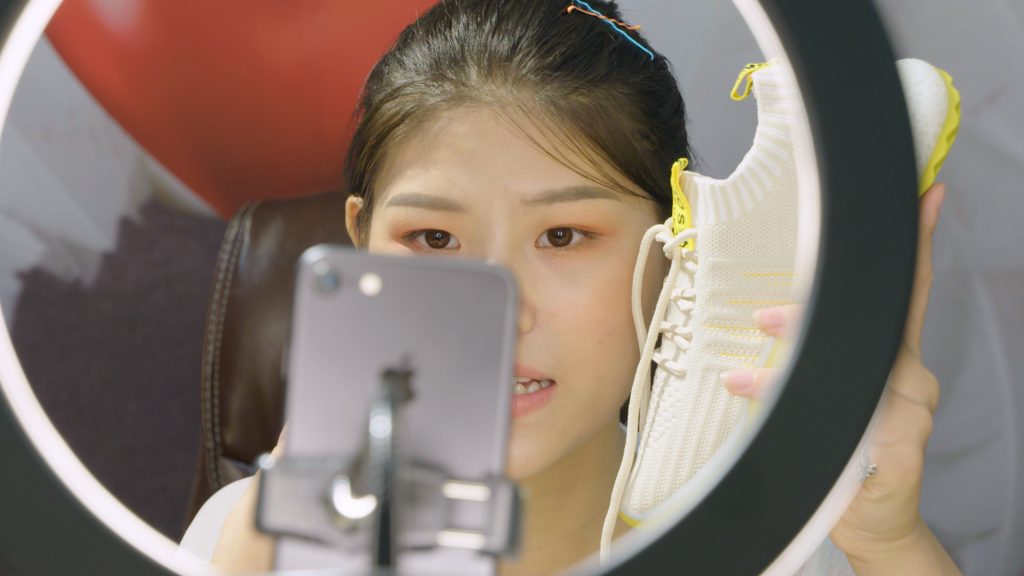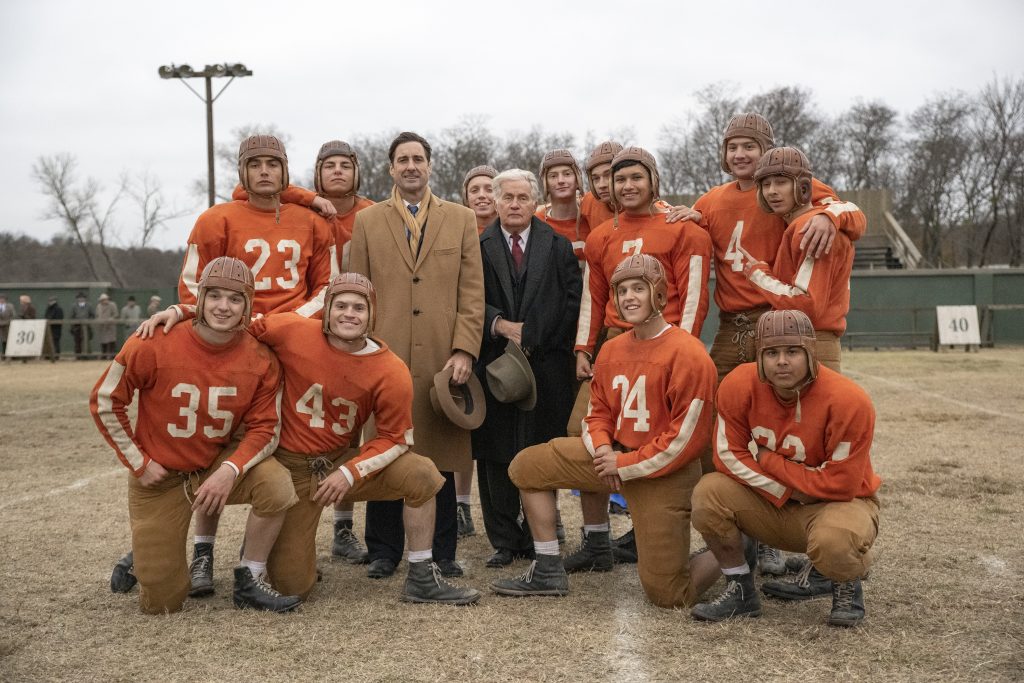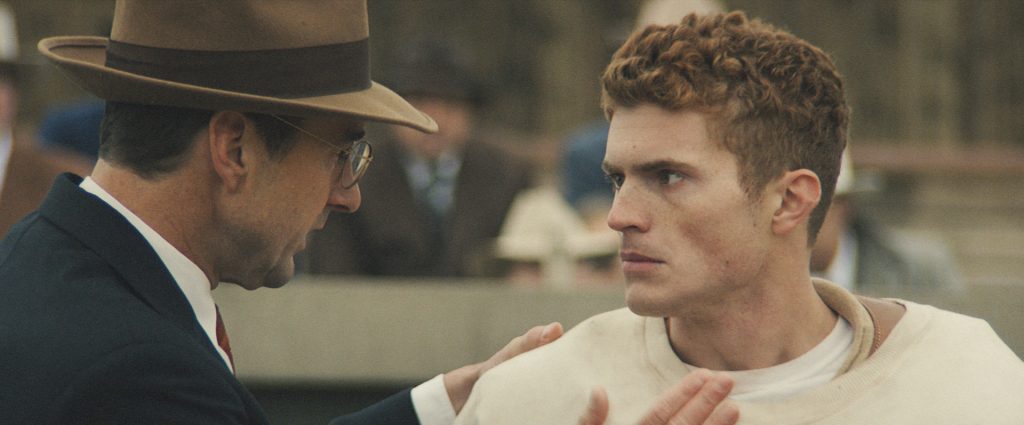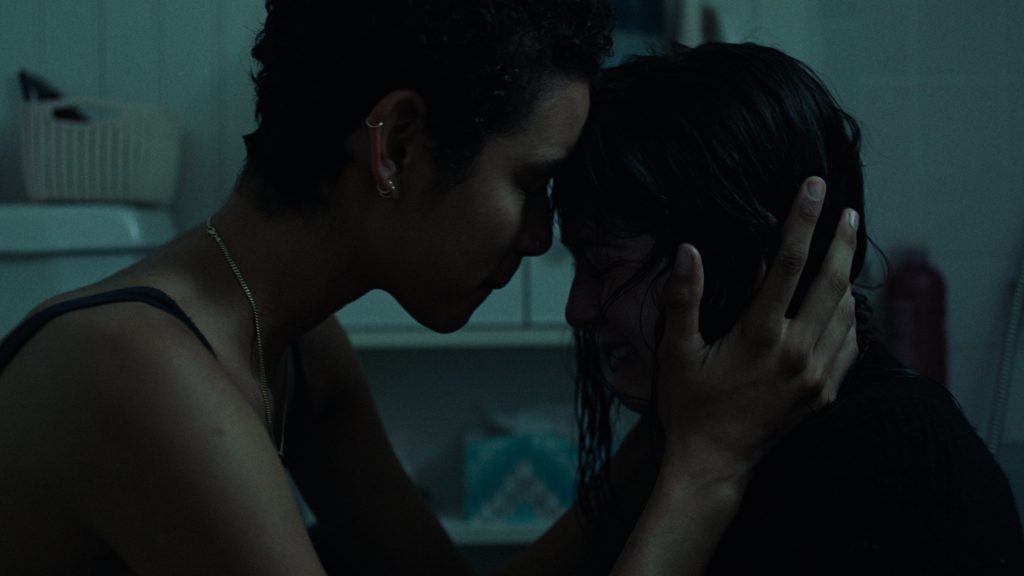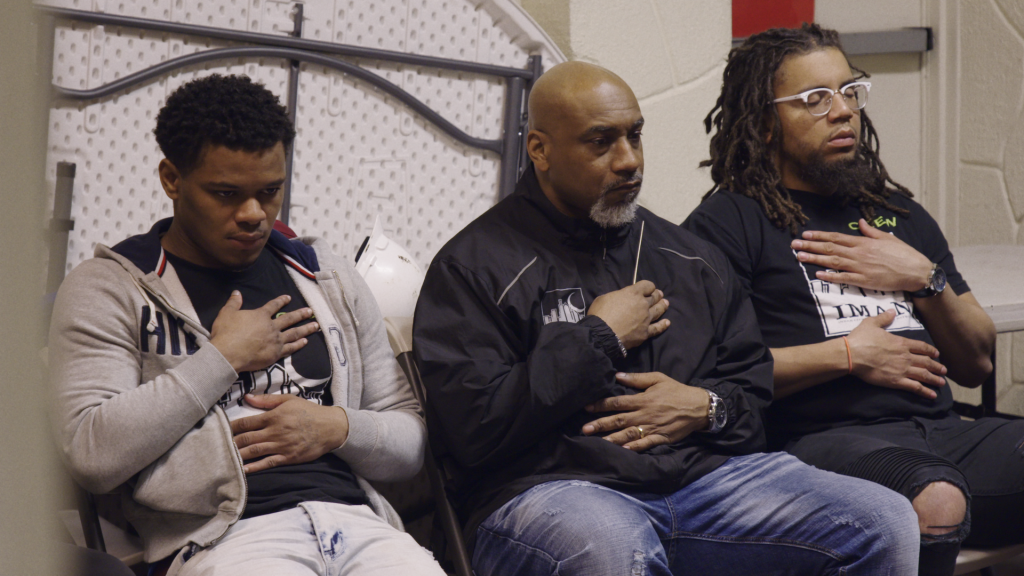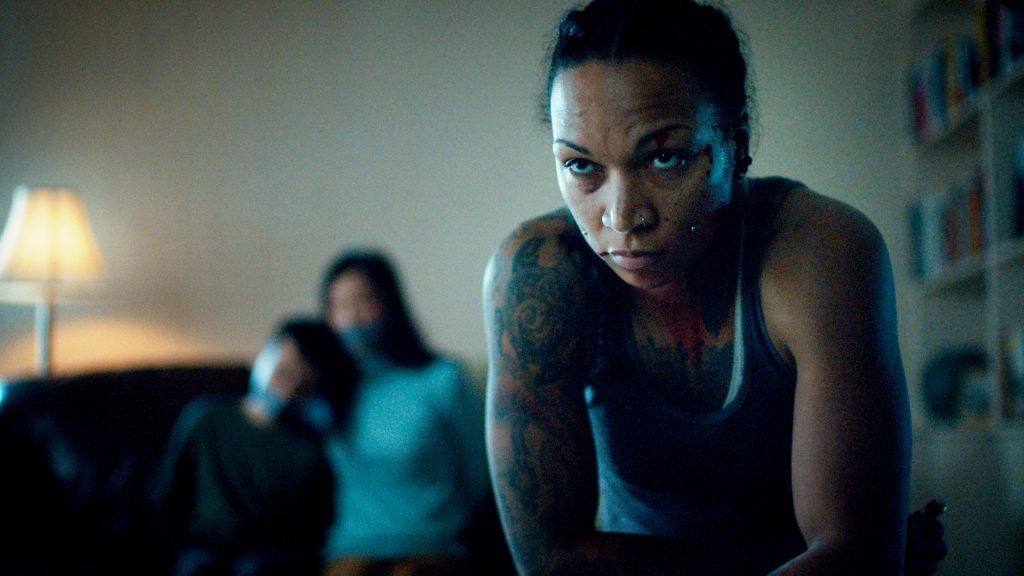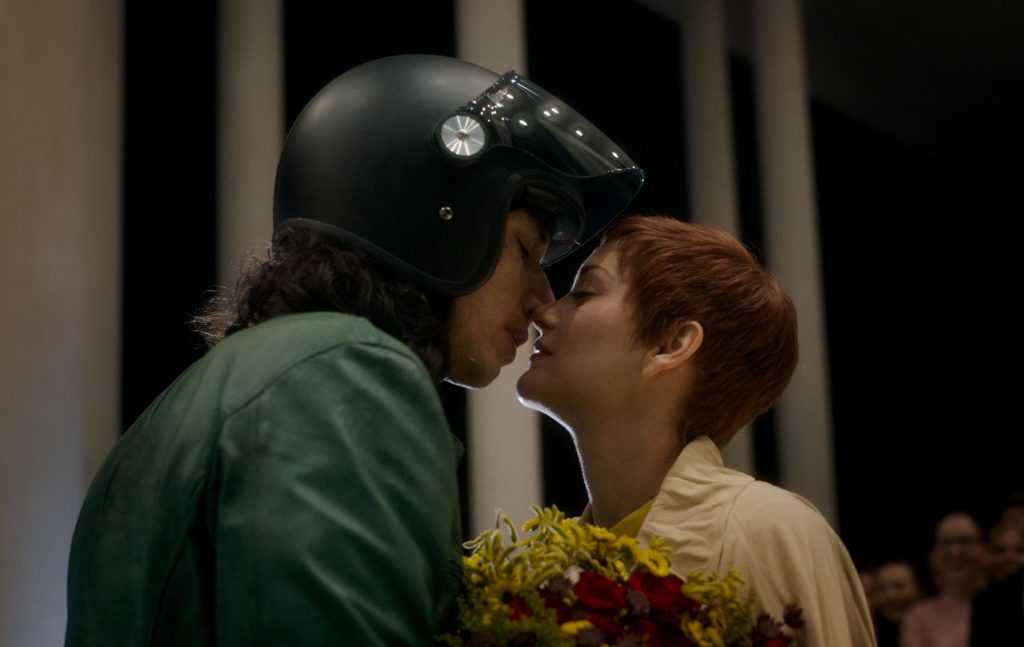June 27, 2021
by Carla Hay
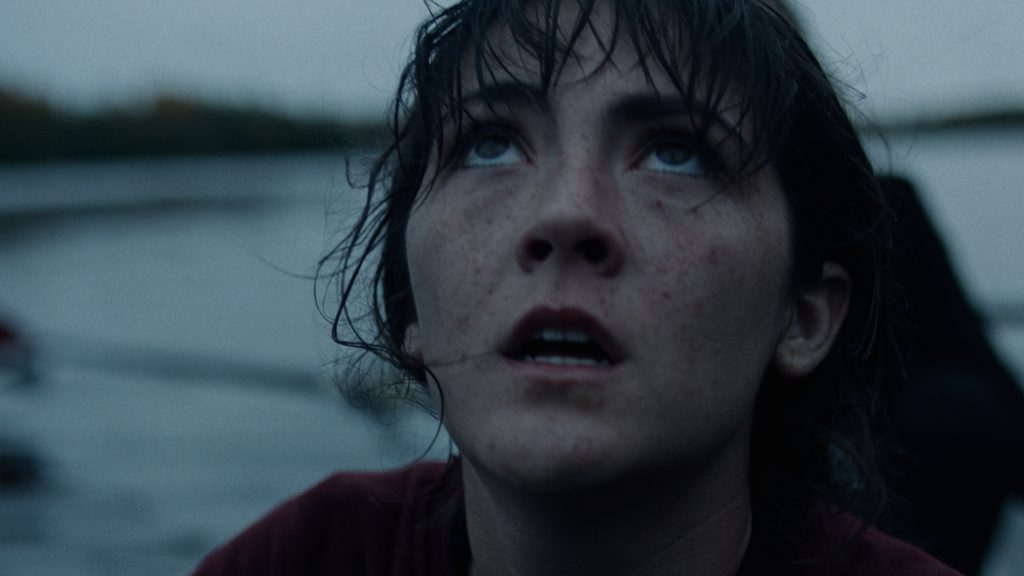
Directed by Lauren Hadaway
Culture Representation: Taking place in an unnamed U.S. city, the dramatic film “The Novice” features a predominantly white cast of characters (with a few African Americans) representing the middle-class and working-class and who are connected in some way to a well-known university.
Culture Clash: A newcomer to a prestigious university’s women’s rowing team pushes herself to her physical, emotional and mental limits.
Culture Audience: “The Novice” will appeal mainly to people who are interested in movies about blind ambition, self-esteem and how women interact in traditionally male-dominated sports.

“The Novice” takes a harrowing and effective look at the dark side of being an overachiever. Isabelle Fuhrman gives a noteworthy performance as a college student who finds out the hard way that winning isn’t worth it if you lose yourself in the process. At times, “The Novice” (which takes place over the course of one academic year) can be a bit too repetitive in hammering this point into the movie’s plot. But through some striking cinematography and sound design, “The Novice” succeeds in building a very specific world, told from the protagonist’s point of view, where the protagonist’s raw emotions and single-minded ambition can be felt by viewers on a visceral level.
Written and directed by Lauren Hadaway, “The Novice” is Hadaway’s feature-film directorial debut, after several years of experience working in film sound. Her extensive background in sound can be experienced all over “The Novice,” which often uses a technique that depicts how someone often tunes out sound around them because they are focused on something else. “The Novice” had its world premiere at the 2021 Tribeca Film Festival in New York City. The movie won three prizes at the festival: Best U.S. Narrative Feature Film; Best Actress in a U.S. Narrative Feature Film (for Fuhrman); and Best Cinematography in a U.S. Narrative Feature Film (for Todd Martin).
If there’s a lot of “tune out” sound techniques in “The Novice,” that’s because Furhman’s Alex Dall character in “The Novice” does a lot of tuning out in her life, so that she can have a single-minded focus on whatever goal is her current obsession. Alex is in her second or third year of an unnamed East Coast university in the U.S. (the movie was actually filmed in Peterborough, New Hampshire), where she is a physics major. When she joins the university’s Ravens rowing team for women as a novice, it sets her down a self-destructive path where she becomes consumed with the goal to be the best rower on the team, no matter what happens.
Just to give you an idea of what type of person Alex is, at one point in the movie, a physics teaching assistant named Dani (played by Dilone) points out to Alex that physics is Alex’s worst subject in school. However, Alex has chosen physics as her major. Why? Because Alex is the type of person who likes being an underdog and who can prove skeptics and naysayers wrong when they underestimate her.
Alex also believes that the people who deserve the greatest rewards in life are the ones who work the hardest, not necessarily those who are the most naturally gifted, the smartest, or those with the best personalities. It’s why she continues to push herself in her physics classes and won’t switch majors, even though she’s struggling with mediocre grades in physics.
Whereas most university students would choose a major in a subject that they truly enjoy, that’s not Alex’s way of doing things. After a while, observant viewers will notice that Alex doesn’t have a passion for physics. However, she won’t change her major because she’s the type of person who thinks that once she chooses to do something, she has to be the best at it. If she changed her major, she would consider it a “failure” in judgment and “failure” in persistence.
Alex has the same mentality when she joins the novice crew of the university’s women’s rowing team. The novices train with the knowledge that only a select few will be chosen for the university’s varsity rowing team, which is the team that competes in the official rowing matches. It’s mentioned early on in the movie that this unnamed university is an elite institution, where most of the students were top achievers in high school and probably for most of their lives.
Even though Alex has no previous experience in rowing as a sport, she approaches her training with the same “I have to be the best no matter what” attitude. For someone like Alex, she doesn’t just want to win and be the best. She wants to break records.
The trainer of the novices is an easygoing and friendly leader named Coach Pete (played by Jonathan Cherry), while the trainer of the varsity team members is Coach Edwards (played by Kate Drummond), who is more aloof and rigid than Coach Pete. A woman named Erin (played by Charlotte Ubben) is an assistant coach who works directly with Coach Edwards. Erin has a similar no-nonsense attitude as Coach Edwards, but Erin is more approachable to the students on the team than Coach Edwards is.
Alex’s best friend at school is fun-loving Winona (played by Jeni Ross), who seems as content with her life as Alex is restless with her own life. There are a few scenes where Alex and Winona hang out together, but their friendship eventually fades into the background as Alex becomes more obsessed with being the best on the rowing team. Alex does take time to have a social life, but nothing is more important to Alex than being considered a success at whatever she does.
There’s a scene early on in the film where Alex and Winona go to a party, Alex meets a guy there, and they have sex that ends too quickly because of his “performance issues.” Alex cringes and half-jokes about it when she and Winona talk about it the next day. Dating is not a major priority for Alex, and she doesn’t put a label on her sexuality.
Later on in the movie, Alex and Dani, who’ve been having a mild flirtation with each other, become lovers around the same time that Dani has moved on from being Alex’s teaching assistant because Dani got accepted into another graduate program. Dani is very sarcastic with Alex in the beginning of their relationship. But as they grow closer, Dani shows a more sensitive and caring side, and she becomes the closest thing that Alex has to a therapist.
Dani also moonlights as a singer. She and her band perform moody, somewhat experimental pop/rock music. The only reason why this aspect of Dani’s life is shown in the movie is because Dani invited Alex to see her perform at a nightclub. It’s during this date that Dani and Alex acknowledge their sexual attraction to each other, and they sleep together for the first time as as a result of that date.
Alex stands out from the other novices because she’s the one who works the hardest. And so by October, which viewers can assume is just a month or two after Alex joined the team of novice rowers, Alex is selected to be on the varsity team. The varsity team will be doing a regatta in the following week. It’s not a lot of time to prepare, but Alex is up for the challenge.
In every sports team, there’s rivalry among the team members. And for Alex, her biggest team rival is Jamie Brill (played by Amy Forsyth), another novice who was selected to be on the varsity team. Jamie has an athletic scholarship to attend the university, and her participation and achievements in the row crew are a condition of keeping her scholarship. Therefore, the stakes are very high for Jamie on how well she does in these rowing competitions.
Early on in the movie, Jamie confidently accepts Alex’s praise that Jamie is the best novice on the team. Jamie is also so self-assured that she defiantly ignores the attempts of the varsity team members to haze and belittle the novices. For example, during a bus ride, she refuses some varsity team members’ orders that novices have to sit at the back of the bus. When Jamie notices that Alex wants to outshine everyone, their relationship becomes a lot less cordial.
Jamie openly expresses her resentment of the rowing team’s most privileged students, whom she calls “silver spoon bitches,” because they don’t have to worry about how they’re going to pay for the school’s tuition. Because of the way that Alex guns so hard to be the top person on the team, Jamie assumes that Alex is driven by the same motivation that Jamie has: to keep an athletic scholarship. When Jamie finds out how Alex’s tuition is being paid, it leads to an explosive confrontation between Jamie and Alex that’s one of the best scenes in the movie.
“The Novice” shows plenty of ways that Alex pushes herself to be the best on this rowing team. During the first meeting of the novices, she’s the only one to take notes. She continues to take notes throughout her entire training. And she repeats mantras to herself, sometimes out loud. Her obsessiveness eventually alienates her from the other team members, a few of whom openly call Alex a “psycho.”
Her über-competitiveness takes a toll on her physically. Like any intense sports movie, there’s plenty of blood, sweat and tears. And whether queasy viewers like it or not, there’s urine. Alex pushes herself so hard during a training session, when she collapses out of physical exhaustion, she’s so tired that she can’t get up, and she urinates on herself. In this scene, the camera pans up so that viewers can see Alex sprawled on her back, on a locker room floor, as some her teammates watch uncomfortably when Alex’s urine starts to form in a puddle around her.
The movie makes the point over and over that no one is harder on Alex than Alex herself. She doesn’t have a sadistic or overly demanding coach. She doesn’t have parents who are pressuring her to be number one in everything she does. (Alex’s parents aren’t even seen or mentioned in the movie.) And she doesn’t have a bullying rival (who’s usually the chief villain in a lot of sports movies) on another team or on her own team.
“The Novice” depicts Alex’s single-mindedness in many of the scenes where the loudest sounds are of her heavy breathing, even when she’s surrounded by other people. In the rowing competition scenes, the cinematography and Alex Weston’s musical score often have a frantic and jagged intensity, similar to a horror movie, in order to take viewers inside Alex’s increasingly disturbed mind.
Alex’s training scenes often evoke a sense of grimness and gloom. And yes, there are predictable scenes of Alex screaming at the top of her lungs when she’s by herself, just to make sure that viewers see the anguish that she’s feeling inside of herself. A pivotal scene toward the end of the movie is an example of the deep fear of failing that drives Alex to put her own safety at risk.
The movie also has several scenes of her running to get to certain places on time, as if her schedule is so packed that she barely has time to go where she needs to go. Meanwhile, there are other scenes where people such as Coach Pete or Dani gently and tactfully tell Alex that she shouldn’t be so hard on herself. She ignores any and all advice to “lighten up” and have some fun with her rowing activities. This repetition all makes it very obvious that Alex is headed for some kind of meltdown.
“The Novice” will be best appreciated if viewers know before seeing the movie that it’s more of a psychological drama than a sports drama. Whether or not Alex and her team become champions is not the point. It’s a story about what can happen to someone who thinks failure is not an option because that person wants to shut out the harsh reality that failure is a part of life.
UPDATE: IFC Films will release “The Novice” in select U.S. cinemas, on digital and VOD on December 17, 2021.

